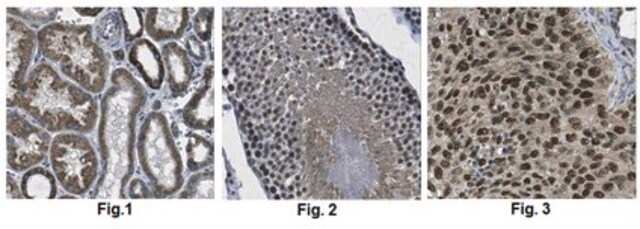05-1320-M
Anti-EED Antibody, clone AA19
ascites fluid, from mouse
Sinónimos:
WD protein associating with integrin cytoplasmic tails 1, embryonic ectoderm development
About This Item
Productos recomendados
origen biológico
mouse
Nivel de calidad
forma del anticuerpo
ascites fluid
tipo de anticuerpo
primary antibodies
clon
monoclonal
reactividad de especies
human, mouse
técnicas
western blot: suitable
isotipo
IgG2aκ
Nº de acceso NCBI
Nº de acceso UniProt
modificación del objetivo postraduccional
unmodified
Información sobre el gen
human ... EED(8726)
mouse ... Eed(13626)
Descripción general
Especificidad
Inmunógeno
Aplicación
Epigenetics & Nuclear Function
Apoptosis & Cancer
Chromatin Biology
Calidad
Western Blot Analysis: 1:5,000 of this lot detected EED on 15 μg/mL of A431 cell lysate.
Descripción de destino
Forma física
Almacenamiento y estabilidad
For maximum recovery of product, centrifuge the vial prior to removing the cap. Avoid repeated freeze/thaw cycles, which may damage IgG and affect product performance.
Nota de análisis
A431 Cell Lysate
Otras notas
Cláusula de descargo de responsabilidad
¿No encuentra el producto adecuado?
Pruebe nuestro Herramienta de selección de productos.
Código de clase de almacenamiento
12 - Non Combustible Liquids
Clase de riesgo para el agua (WGK)
WGK 1
Punto de inflamabilidad (°F)
Not applicable
Punto de inflamabilidad (°C)
Not applicable
Certificados de análisis (COA)
Busque Certificados de análisis (COA) introduciendo el número de lote del producto. Los números de lote se encuentran en la etiqueta del producto después de las palabras «Lot» o «Batch»
¿Ya tiene este producto?
Encuentre la documentación para los productos que ha comprado recientemente en la Biblioteca de documentos.
Nuestro equipo de científicos tiene experiencia en todas las áreas de investigación: Ciencias de la vida, Ciencia de los materiales, Síntesis química, Cromatografía, Analítica y muchas otras.
Póngase en contacto con el Servicio técnico